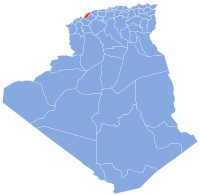This is an old revision of this page, as edited by Esoglou (talk | contribs) at 16:01, 29 January 2014 (clarified and sourced history). The present address (URL) is a permanent link to this revision, which may differ significantly from the current revision.
Revision as of 16:01, 29 January 2014 by Esoglou (talk | contribs) (clarified and sourced history)(diff) ← Previous revision | Latest revision (diff) | Newer revision → (diff)| This article may require cleanup to meet Misplaced Pages's quality standards. No cleanup reason has been specified. Please help improve this article if you can. (November 2010) (Learn how and when to remove this message) |
35°56′N 0°05′E / 35.933°N 0.083°E / 35.933; 0.083
Commune and town in Mostaganem Province, Algeria| Mostaganem | |
|---|---|
| Commune and town | |
 | |
 Seal Seal | |
| Country | |
| Province | Mostaganem Province |
| District | Aïn Nouïssy District |
| Population | |
| • Total | 145,696 |
| Time zone | UTC+1 (CET) |
Mostaganem (Template:Lang-ar) is a port city in and capital of Mostaganem province, in the northwest of Algeria. The city, founded in the 11th century lies on the Gulf of Arzew, Mediterranean Sea and is 72 km ENE of Oran.It has 145,696 inhabitants as of the 2008 census.
The city was founded in the 11th century as Murustage but has origins going back to Punic and Roman times, when it had the name of Cartenna. In 1516 it was captured by the Ottoman admiral Barbarossa and became a centre for Mediterranean sea corsairs, as well as a commercial port. By 1700 it had come under Ottoman rule and in 1833 the city was taken by France and a garrison established. Algeria became independent in 1962.
History
Mostaganem corresponds to the ancient Punic port of Murustaga. After becoming part of the Roman Empire, it was officially renamed Cartennae under the emperor Gallienus (253–268). However, the old name survived and was used to refer to the town when it became a Christian bishopric, which is included in the Catholic Church's list of episcopal sees, and underlies the modern name.
The town was conquered by the Almoravids and reached its high point of power under Yusuf ibn Tashfin (c. 1061-1106). It was later ruled by the Ziyanids of Tlemcen and the Marinids of Fes. In the 16th century, the town resisted a Spanish invasion and came under the power of the Ottoman Hayreddin Barbarossa.
Present situation
The city is divided in two by a ravine of the river Aïn Sefra, with the modern town to southwest, and the old Muslim city, Tidgit, to the northeast.
In 2010 a tunnel moving under the city towards the city centre is expected to change circulation by a lot. Also, new buildings, some modern and some in colonial style are being added to this growing city. The new autoroute from the capital Algiers towards Oran will make it easier also to access Mostaganem by road from the capital, as Mostaganem has no public airport. The road connecting Oran (around 80 km from Mostaganem to the west) will remain the same, a crowded 2 lane in each direction highway.
The port of Mostaganem is being used for unloading of all sorts of cargo, ranging from provisions to cars and pipelines. As in most ports of Algeria, it is not allowed to sailors to exit the port and visit the city. The port is being shared by large transport vessels and fishing boats alike. A new, smaller port for fishing boats has been constructed, but is currently not used.
Notable people
Mostaganem has given birth to illustrious figures such as playwright Ould Abderrahmane Abdelkader AKA Kaki, cinema director Mohamed Chouikh, historians such as Moulay Belhamissi, and lyricists such as Kadda Medjeded. A major centre of popular and amateur theater, it is home to important specialists of Andalusian classical music (Moulay Benkrizi), Chaabi (Maazouz Bouadjadj, Habib Bettahar), masters of traditional Bedouin music (Sheikh Hamada, Sheikh Djilali Ain Tedeles) and poets such as Sheikh Abdelkader Bentobdji and Sidi Lakhdar Benkhelouf who are authors of well-known qacidates of Malhun poetry bequeathed as much to the Chaabi legacy as to Bedouins such as Abdelkader ya Boualem. Muhammad ibn Ali as-Senussi originated from near Mostaganem.
See also
References
- ^ Murustaga-Mostaganem
- Annuario Pontificio 2013 (Libreria Editrice Vaticana, 2013, ISBN 978-88-209-9070-1), p. 935
External links
- Mostaganem dz by Mohammed Abbassa
- History and old postcards of Algeria
- Annals of Heritage (Journal of the University)
- Mostaganem pictures and many things by S. Benhenda
- Mostaganem Its History, Photograph, Current events, Culture, Geography

